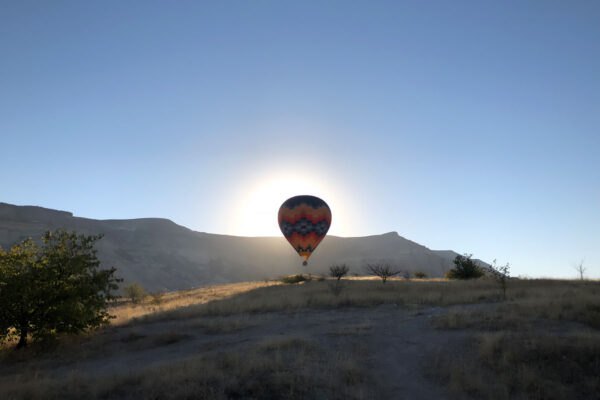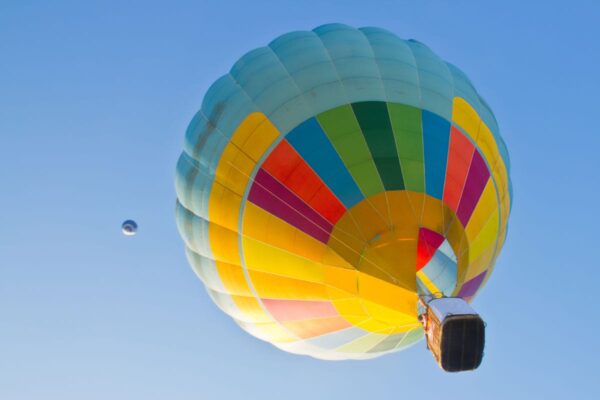The World of Ballooning has fascinated people for centuries, offering unique experiences related to flying. However, not all balloons are the same—there are significant differences between tourist balloons and sport balloons that affect how they are used and their capabilities. Tourist balloons focus on passenger comfort and safety, while sport balloons prioritize maneuvering precision and performance.
The differences between these two types of balloons concern many technical and operational aspects. Design, equipment, operational procedures, and usage goals vary significantly. Tourist balloons are designed with the comfort and safety of a larger number of passengers in mind. Sport balloons, on the other hand, concentrate on performance and precise flight control.
Technical Characteristics of Tourist Balloons
Tourist balloons feature a specific design adapted for transporting passengers in comfortable conditions. The envelope of a tourist balloon usually has a larger volume, which ensures flight stability and safety when carrying more people.
Dimensions and Capacity
Standard tourist balloons have envelopes with volumes ranging from 2800 to 4200 cubic meters. Larger sizes provide greater lift capacity, allowing transport of 8 to 16 passengers simultaneously. The passenger basket is rectangular or round with high sides for safety.
The basket construction uses wicker or modern composite materials. The side height typically measures 120-130 centimeters, providing safety even for tall passengers. The basket floor has a non-slip surface and a shock absorption system for landings.
Propulsion System and Equipment
Tourist balloons are equipped with powerful gas burners producing 3-4 megawatts of power. The fuel system consists of several propane or propane-butane tanks, ensuring long flight duration. System redundancy guarantees safety in case one component fails.
Safety Equipment of Tourist Balloons:
- VHF radio communication system
- GPS and navigation instruments
- Automatic fire extinguisher in the burner compartment
- First aid kit
- Safety instructions in multiple languages
- Safety line attachment system
The onboard instruments include an altimeter, variometer, exhaust gas thermometer, and fuel pressure gauges. All instruments are duplicated to increase safety. The envelope temperature control system prevents material overheating during long flights.
Technical Parameters of Sport Balloons
Sport balloons differ significantly from tourist ones in terms of design and technical parameters. They are designed for maximum performance and precise flight control, making them ideal for competitions and sports training.
Design and Materials
The envelopes of sport balloons have smaller volumes, usually from 2000 to 3000 cubic meters. The envelope material is a special ripstop fabric with increased durability and reduced weight. The design is optimized for rapid heating and cooling of air.
The sport basket is significantly smaller and lighter than the tourist one. It usually carries 2-4 people, allowing for better control of weight and the center of gravity. The basket’s construction uses lightweight composite materials or aluminum.
Control and Precision Systems
Sport balloons are equipped with advanced flight control systems. Burners have power regulation over a wide range, allowing precise heat dosing. The fuel system is optimized for weight savings and combustion efficiency.
Specialized equipment for sport balloons:
- Precise digital altimeter
- High-sensitivity variometer
- GPS with sports functions
- Ballast computer
- Real-time telemetry system
Navigation instruments in sport balloons are much more advanced. They include wind tracking systems at various altitudes, flight trajectory calculators, and software for planning competition routes. All data is recorded for later performance analysis.
Tip: Sport pilots often use special wind maps and meteorological applications that help predict weather conditions at different altitudes during competitions.
Differences in Maneuverability and Controllability
Maneuverability and controllability are key differences between tourist and sport balloons. Sport balloons feature significantly better responsiveness and control precision, which is essential during competitions and advanced training.
System Responsiveness
Sport balloons respond faster to pilot commands due to lower weight and optimized design. The reaction time to burner activation is 2-3 seconds, whereas in tourist balloons it can take 5-8 seconds. Faster response allows for precise maneuvers during competitions.
The temperature control system in sport balloons is more sensitive. The pilot can precisely regulate lift force, enabling flight at a constant altitude with accuracy within a few meters. Tourist balloons have less precision due to greater mass and system inertia.
Piloting Techniques
Piloting a sport balloon requires advanced skills and experience. Techniques include contour flying, precise landings on designated targets, and maneuvers within limited airspace. Sport pilots must master the art of utilizing wind layers at different altitudes.
Tourist balloons are piloted more conservatively. The priority is passenger comfort and flight safety. Maneuvers are gentle and predictable, with pilots avoiding sudden changes in altitude or flight direction.
Tip: Experienced sport pilots can use differences in wind speed at various altitudes to precisely control flight direction, which is crucial during accuracy competitions.
Professional Balloon Flights with ProBallooning
The company stands out for its professional approach to every flight. All pilots undergo regular training and skill assessments. The balloon fleet is regularly serviced and upgraded according to the latest aviation safety standards.
Balloon Flight Services
ProBallooning offers a wide range of services tailored to various customer needs. Tourist flights constitute the main part of the company’s operations, allowing passengers to admire landscapes from a bird’s-eye view. Each flight is carefully planned considering weather conditions and participants’ preferences.
The company also organizes special occasion flights, such as romantic rides for couples, business flights, and corporate events. Special packages include sunrise or sunset flights, providing unique visual experiences and photographic opportunities.
Types of flights offered by ProBallooning:
- Scenic flights over picturesque regions
- Romantic balloon flights for two
- Family flights
- Private flights for companies and organizations
The company provides full logistical support, including transportation to the launch site and from the landing site. Each flight is preceded by a safety briefing and passenger instructions. After the flight, participants receive a certificate confirming their participation in the balloon adventure.
Reviews and Reputation
ProBallooning enjoys an excellent reputation among customers, confirmed by numerous positive reviews and high ratings. The company consistently receives top marks for professionalism, safety, and quality of services provided. Customers particularly appreciate the pilots’ experience and attention to every detail of the flight.
Positive reviews also highlight excellent flight organization and a friendly atmosphere. Passengers praise communication with the company, punctuality, and flexibility in accommodating individual needs. The high quality of services translates into customer loyalty and recommendations to friends.
The Impact of Weather Conditions on Both Types of Flights
Weather conditions have a crucial impact on the safety and feasibility of balloon flights. Both tourist and sport balloons are sensitive to weather changes, but to varying degrees and with different consequences for flight operations.
Weather Restrictions
Wind speed is a fundamental limitation for balloon flights. Tourist balloons can fly in winds up to 15-20 km/h, while sport balloons tolerate slightly higher speeds up to 25 km/h. Atmospheric turbulence is especially dangerous for larger tourist balloons due to the greater surface area of the envelope.
Atmospheric visibility must be at least 5 kilometers for a safe flight. Fog, rain, or snow prevent balloon launches. Air temperature affects burner efficiency and the lifting force of the envelope, requiring appropriate adjustments in flight planning.
Meteorological Planning
Balloon pilots analyze weather forecasts several days before the planned flight. They pay special attention to wind profiles at different altitudes, atmospheric stability, and expected weather changes. Sport balloons require more detailed meteorological analysis due to the precise demands of competitions.
Key Meteorological Parameters:
- Surface wind speed and direction
- Wind profiles up to 3000 meters altitude
- Atmospheric stability and turbulence
- Horizontal and vertical visibility
- Probability of precipitation
Weather forecasting systems for ballooning use specialized atmospheric models. Data are updated every few hours, allowing flight decisions based on the latest meteorological information.
Tip: Experienced balloon pilots often use local meteorological stations and field observations, which can be more accurate than general weather forecasts for a given region.
Launch and Landing Procedures in Tourism and Sport
Launch and landing procedures differ significantly between tourist and sport flights. Tourist balloons require more formalized procedures due to passenger safety, while sport balloons focus on precision and maneuvering efficiency.
Pre-Launch Preparation
Pre-launch procedures for tourist balloons include a detailed safety briefing for all passengers. Instructions cover positions during launch and landing, behavior in the basket, and emergency procedures. Pilots check passengers’ documents and health status before the flight.
Sport balloons have simplified pre-launch procedures focusing on technical aspects. Equipment checks are more thorough, including calibration of navigation instruments and testing communication systems. Pilots analyze weather conditions and plan flight strategy.
Landing Techniques
Landings of tourist balloons are planned with a large safety margin. Pilots choose large open spaces with gentle terrain slopes. Landing speed is minimized, and passengers receive detailed instructions regarding their position upon ground contact.
| Landing Aspect | Tourist Balloons | Sport Balloons |
|---|---|---|
| Site Selection | Large, safe fields | Precise competition targets |
| Landing Speed | Minimal (2-5 km/h) | Controlled (5-15 km/h) |
| Technique | Gentle, gradual | Precise, targeted |
| Ground Support | Rescue team | Competition judges |
Sport balloons perform precise landings on designated targets. Pilots must master pinpoint landing techniques with accuracy within a few meters. Landing speed may be higher but is carefully controlled by experienced pilots.
Tip: During the landing of a tourist balloon, passengers should hold firmly onto the basket handles and slightly bend their knees to absorb any impact with the ground.
Summary
The differences between tourist and sport balloons are significant and affect all aspects of design and operation. Tourist balloons prioritize passenger safety and comfort, while sport balloons focus on performance and precise flight control. The choice of balloon type depends on the flight goals and participants’ experience.
Understanding these differences is essential for those planning a ballooning adventure. Tourist flights offer relaxing experiences and opportunities to admire landscapes, while sport balloons provide exciting challenges and chances to develop piloting skills. Regardless of the choice, both types of balloons guarantee unforgettable flying experiences.





